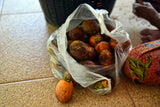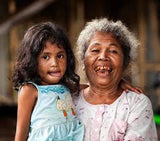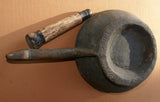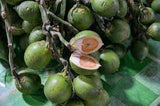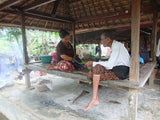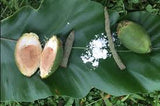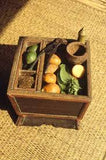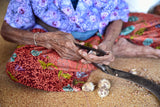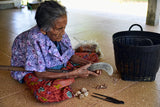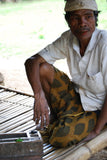ANTIQUE 1800’s PRIMITIVE WOOD DISH WITH HANDLE IN THE SHAPE OF A BIRD’S HEAD: INCLUDED IS A BUFFALO BONE & WOOD POUNDER, BOTH COLLECTED FROM A SHAMAN IN LOMBOK ISLAND, INDONESIA, 30 YEARS AGO, USED FOR BETEL HABIT & POTIONS.
2 wonderful older items to add to any Betel habit collection: Collected from the Sasak people of Lombok, Lesser Sunda Islands, Indonesia.
Very rare highly collectible antique wooden dish estimated to be 100 years old or more, collected in Lombok Island, Indonesia. It was used by a Shaman to crush herbs, magic powders, and betel-lime concoctions, with the help of a buffalo bone and wood pounder or crusher that we purchased as well and left it with. The crusher is not as old as the dish. Both were handmade at different times.
DISH IS 11 1/2" LONG WITH HANDLE INCLUDED. DIAMETER IS 6 1/2" AN BOWL IS 3" HIGH.
Also, with it, a wonderful Vintage Sirih pounder or Pestle, hand carved out of bone and wood and used in the preparation of a Betel Nut Chew, The Pelacok (pronounced Pelor-choc) is a tool used by older people when they lose their teeth and can no longer chew betel nut, the hard seed of the Areca palm. It is made to insert inside a deep mortar. The betel chewer inserts the betel nut in the mortar and chops and crushes it before wrapping it with the pepper leaf and white lime powder to create a mildly narcotic called betel chew, also from Lombok, Lesser Sunda Islands, Indonesia.
POUNDER IS 5 " LONG (HAND CARVED BUFFALO BONE & WOOD).
At one time it was believed that nearly a tenth of the world’s population was addicted to betel chewing. Today most modern young people have turned away from the habit, especially in the more industrialized areas.
The medicinal qualities of the addictive areca nut is questionable, but it gives a feeling of euphoria, therefore is used by many to ease anxiety or pain. The betel pounding and crushing instruments played a major role in many facets of life that involved the betel habit, such as entertaining, marriage, and the etiquette of the courts.
Please note! Indonesian water buffalo horn and bones are not on the endangered species list, in fact no buffalo is, from the American Buffalo to the Asian or African buffalo.
The fruit of the areca palm (Areca catechu) is chewed together with lime and betel pepper as a stimulant by peoples of the East and Papua New Guinea, among other places. Chewing it blackens the teeth and stains the mouth deep red.
Betel is one of the oldest intoxicants and was the most popular until the beginning of this century. Betel is classified as a mild stimulant similar to coffee. It has a multitude of meanings and uses, and the habit of chewing betel is well integrated into the different communities of the Golden Triangle as most of Asia .
Betel consists of three main ingredients. The leaf comes from a creeper called the betel plant. The second ingredient is a nut from areca palm, and the third is lime that is made from ground seashells or artificially manufactured. These ingredients form the betel quid that is chewed. In addition, other items such as tobacco, spices or medicinal plants may be added as desired.
In order to make a betel quid, you need a betel set. This consists of a number of containers for the different ingredients, a cutter or knife to cut up the areca nut and a mortar and pestle to mix the ingredients together.
Betel chewing causes a rapid production of saliva of a strong red color. After many years one’s teeth become black as a result. Red lips and black teeth were previously thought to be a sign of beauty, especially for young women. "Only dogs, ghosts and Europeans had white teeth!"
Betel played an important role in social interaction. A betel set was placed in front of a guest as a gesture of good manners. If the betel set was removed, it meant that the visit should be terminated. In courtship a gift of a betel quid was a sign of affection.
Betel was used extensively in rituals. In exorcism rituals betel was used as a means of transferring magical powers in order to drive out evil spirits. At marriage rituals, the couple was given a betel set for two symbolising unity and fertility. In addition, the ancestral spirits received regular offerings of betel from the living.
Those who chew betel have always claimed that it has positive effects on the body. Western medicine has since verified this. Chewing betel protects teeth from bacteria and aids in digestion. The combination of ingredients in the betel quid actually kills a number of harmful stomach parasites.
Betel was very popular among all ethnic groups in Southeast Asia but is now only use by elderly women. Western ideals about appearances (white teeth) and hygiene (rules against spitting and the spread of diseases) have influenced local attitudes. The use of betel has decreased dramatically over the last 50 years and has been replaced by tobacco.
All our collector and rare items come with pages and pages of research about provenance, and with history of the tribes and photos as well, depending on item and whenever possible. When shipping internationally, we group ship multiple purchases to save you money. If you have any questions or want to see research conducted on this piece and photos of tribes, let us know.















































